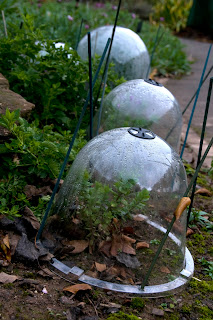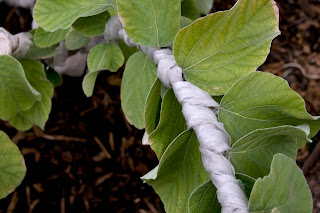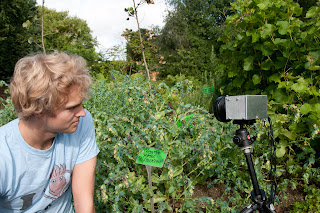We all have different approaches to our gardening. Mine is very much a ‘survival of the fittest’ style. You will not find any high maintenance plants in my garden and it’s not from a lack of interest – it’s merely a reflection of my personality and lifestyle. However, when you house over 4,500 species from all over the world, as the
Botanic Garden does, there needs to be some serious plant coddling. Particularly at this time of year as the days get shorter, temperatures drop and rain is inevitable. Plants that are adapted to winterless weather need some special attention and so the staff and volunteers at the Garden are very busy right now putting the garden to bed.
Andy Winfield, a botanical horticulturalist who’s been working at the Botanic Garden for nearly twelve years, toured me around last week to show me some of the special treatments the plants are getting in preparation for winter. The first stop…bananas!
A few weeks ago when I was here, these banana plants were lush and green and reminding me of tropical places. Now there is no sign of that lush foliage, and some intriguing looking tee-pees stand in their place.
 |
The banana plants are prepared for
the winter ahead beneath many
layers of insulation. |
“We start with a framework of bamboo,” explains Andy, “then around that we put some stiff plastic to form a funnel, which we push loads of straw into, down around the trunk of the plant. On top of that we put a little plastic hat to stop the rain coming in and soaking the straw. The leaves of the plants have been cut right back, so it’s the trunk that we are protecting over the winter. If rain gets in and the plant isn’t putting on any growth due to the cold weather, the trunk will just turn to mush.
“Then around the plastic cone, we wrap some fleece. Finally, we wrap the bamboo supporting structure in green netting, which goes around and encompasses the whole lot. We also pile bark mulch around the base of the plant to protect the roots.”
This process will take two people nearly an entire day to wrap three trees. It’s a labour of love to be sure, but it’s also a tried and true method. They’ve been using this method at the Garden for years -through wet winters, cold winters, and even really cold winters, and the bananas have come through it all.
 |
The leaves of the Gunnera manicata are placed over the
the crown of the plants as part of the winterising process,
which also gives an interesting display. |
Next on the tour is the Gunnera manicata, commonly called giant rhubarb. The giant leaves of this Brazilian native, which normally dominate the pond area have all been cut back and inverted into what can only be equated to little hobbit-like homes.
“This plant wouldn’t normally have a dormant period where it’s from, but here we need to protect it through the winter,” said Andy. “It has a great big crown, which is the growing point and that is what we need to protect. So we cut off all the leaves, and cover the crown in bark. Then we keep the bark in place by using the leaves as a cover. We tie a number of them together and invert them over the top, then firm them in place with more bark around the outside. It’s functional, but it also provides a structural display.”
As we walk past some cloches placed to protect some dry-loving Mediterranean plants from our wet south west winter, Andy explains some of the process behind putting the garden to bed.
“We consider each plant individually – where it comes from and what its needs are. Then we have a think about how best to protect it over the winter.”
 |
Cloches protecting plants from the
wet of winter. |
In fact, they have a list at the Garden with every species named along with very specific instructions for preparing it for winter. I’ve seen this list – it’s 21 pages long! Each year, Nicola Rathbone one of the horticulturalists at the Garden, goes around with the previous year’s list and updates it – adding new arrivals to the list and taking the less fortunate off. Then, it’s a matter of setting to work and starting with the most vulnerable plants, like the cycads and bananas, first. Work starts just before the first threat of frost, which was October this year, and by November things are in full swing.
Next, Andy takes me into the evolutionary dell – one of my favourite parts of the garden. The tree ferns haven’t had anything done to them yet, but shortly they will have some straw stuffed into their crowns and a little plastic hat placed on top to protect them from any penetrating cold or frost. Andy and the other staff keep a close eye on the weather in the winter and if a prolonged cold spell is in the forecast, the tree ferns will also get wrapped in fleece to insulate their trunks from the cold.
Some of the cycads, which are buried in the garden in pots, have been lifted, pot and all, out of the ground and placed in the glass houses. A couple of these plants have been a part of the garden for over 60 years and are substantial in size, and so this is a considerable job to transfer these individuals, and it’s all done by hand. The more hardy cycads are left in the ground and given the same treatment as the banana trees.
 |
| Branches are swaddled to protect them from winter frost. |
As we walk out of the dell, my eye finally starts to tune into the individualised approach that has been taken to protecting the Garden’s investments. There are ‘mummified’ trees and shrubs that have had their trunks and branches swaddled in cloth to protect them from the cold. Little glass domes peek out randomly throughout the garden and some of these cloches are filled with straw, to give protection against the cold as well as the wet. Some plants, such as the Daphne bholua ‘Jaqueline Postill’ have a wall of netting on only their north-facing side to protect them from cold north winds, while other plants are completely surrounded by netting. One of the volunteers, Sue, is hammering in a netting screen as we walk by.
“It’s a huge job putting the garden to bed,” says Andy, “and it really comes down to the help of our volunteers. We can’t stress enough how invaluable they are to us. This garden was built on volunteers really, if they weren’t here, this would all be mud and I’d be lying somewhere over there exhausted.”
Once the plants in the garden have been protected for winter, the staff and volunteers will turn their attentions to the many projects that get pushed down the priority list in the busier seasons. For instance, a section is being prepared for a new Somerset levels display. So it would seem that not only is there always something to see in the Botanic Garden, there is inevitably always something to do – even once it’s been put to bed.







